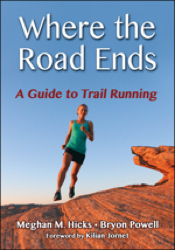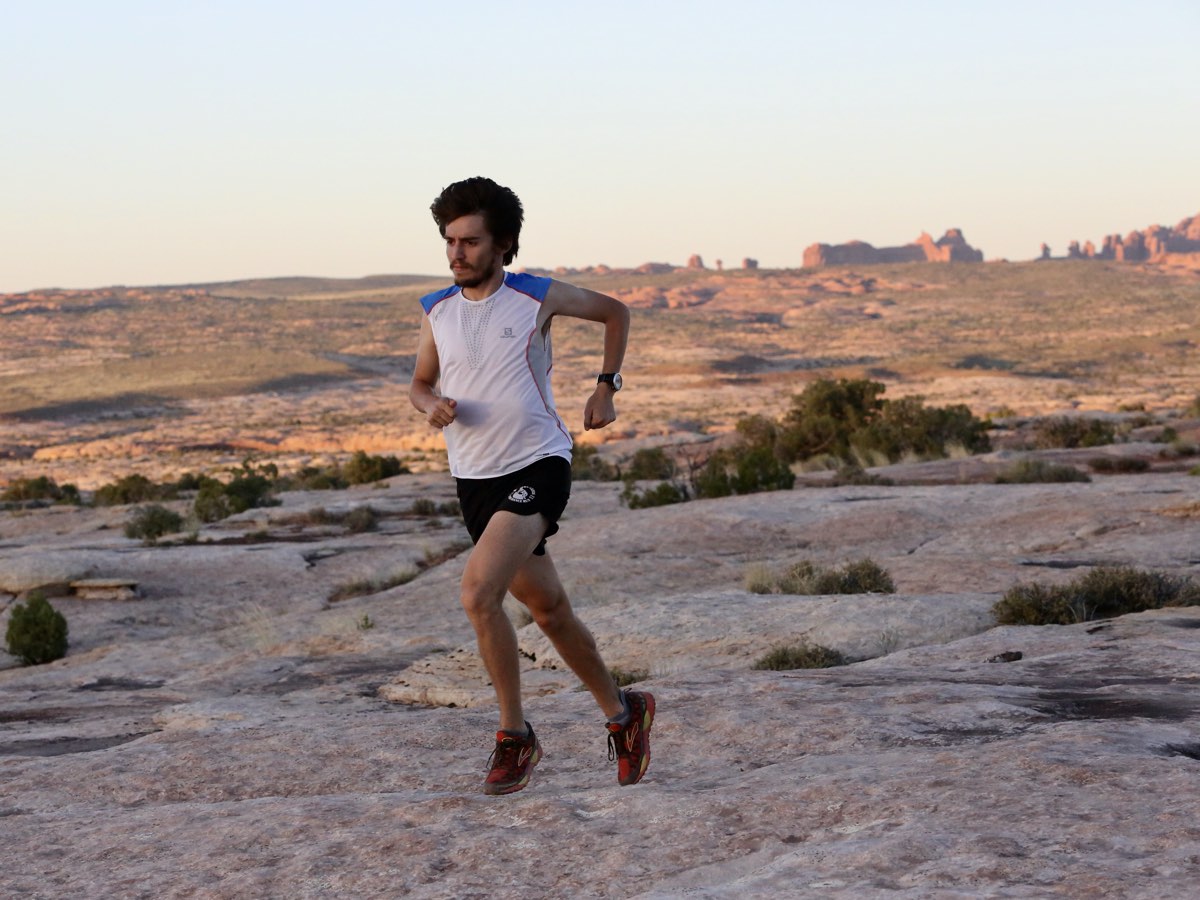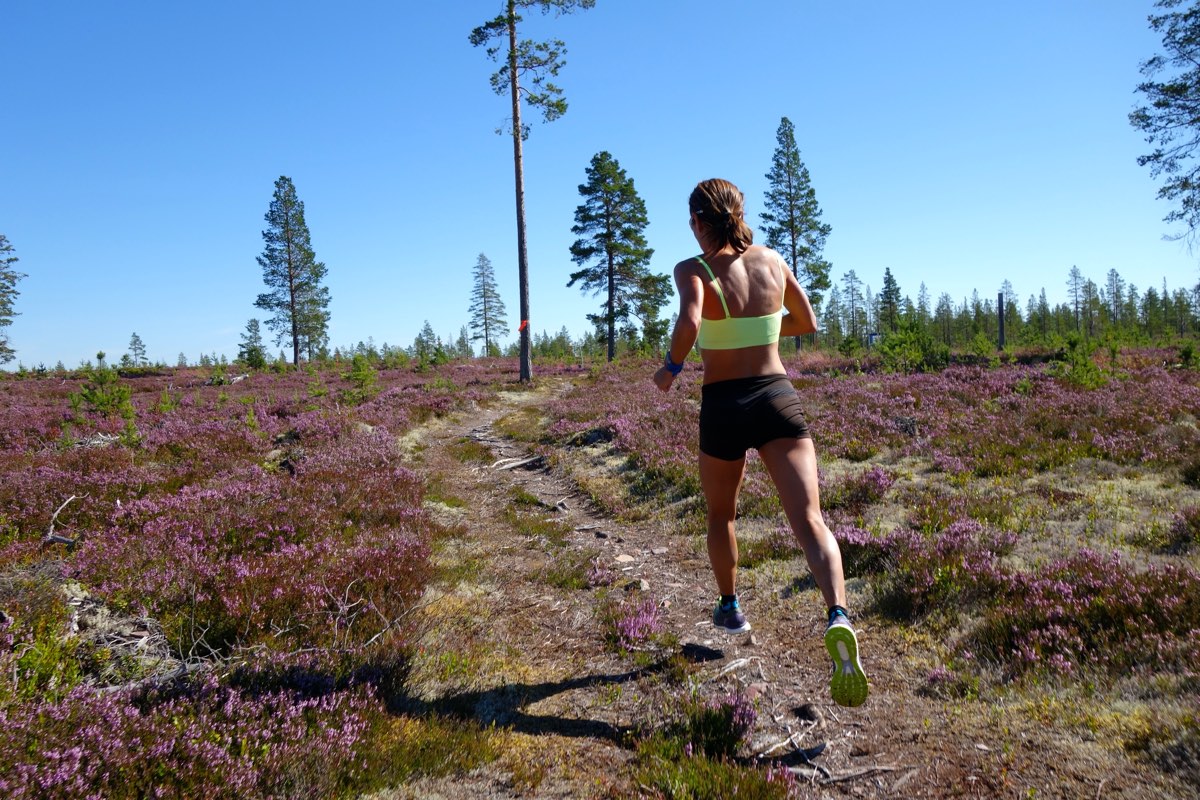
Like this article? Get your copy of the book “Where the Road Ends!”
Welcome to this month’s edition of “Where the Road Ends: A Guide to Trail Running!” That’s the name of both this column and the book Meghan Hicks and Bryon Powell of iRunFar published in 2016. The book Where the Road Ends: A Guide to Trail Running is a how-to guide for trail running. We worked with publisher Human Kinetics to develop a book offering the information anyone needs to get started, stay safe, and feel inspired with their trail running. The book Where the Road Ends teaches you how to negotiate technical trails, read a map, build your own training plan, understand the basics of what to drink and eat when you run, and so much more.
This column aims to do the same by publishing sections from the book as well as encouraging conversation in the comments section of each article. We want you to feel inspired and confident as you take on your first few trail runs as well as connected to iRunFar’s community of trail runners!
From clothes to shoes and from running packs to headlamps, using the right gear for trail running will improve your experience. That said, you don’t need to be a gear geek as you become a trail runner. A little bit of the right gear will take you a long way!
This article is the second in a three-part series on the basic trail tools you might want to make your trail running more comfortable, enjoyable, and safe. In part 1 last month, we talked about trail running shoes. Here in part 2, we look at clothing. And next month in part three, we’ll cover packs, flashlights, navigation equipment, and a few other accessory items to aid your off-road running. All of these articles are excerpted from Chapter 5 in Where the Road Ends.
Essential Trail Running Clothing
For the most part, running apparel is running apparel. Also, most athletic apparel translates well enough to the trails. The essential trail running kit is in line with what you’d wear for most any sport: some bottoms, a top, a pair of socks, and applicable undergarments. Chances are you can go out for a trail run with something you already have at home. Anyone who tells you otherwise is probably trying to sell you something!
No matter what apparel piece you’re looking to pick up, top international trail runner Anna Frost suggests, “We’re all different, so the only way to find out whether a piece of clothing is for you is to try it. Even if I love this fabric and that fit, someone else who’s the same size as me could think the same fabric is horrible.”
Tops and Bottoms
Because running is a sport in which we engage in the same repetitive motion thousands of times, the friction of clothing against skin can lead to a significant and painful problem: chafing. You’ll quickly learn what types of materials, fits, seams, and other features of a piece of clothing act as skin irritants when you run.
A good pair of athletic bottoms might be the most important part of the mix. If you have a pair of athletic bottoms that are breathable, offer a good range of motion, and are comfortable, they should work. Think gym shorts, yoga pants, or board shorts.
Whatever bottoms you wear, useful features include a secure pocket for a key as well as another pocket or four to stash additional items you might need. Speedster ultrarunner Dylan Bowman notes, “Running shorts with an abundance of pockets are usually particularly expensive in comparison to the other simple necessities inherent to running. However, for me, the cost is a no brainer in exchange for the utility and convenience of having at least one pair of shorts capable of carrying a picnic.”
Those with the applicable body parts will also want to find bottoms with suitable support where you need it, whether that’s from a built-in pair of briefs or some of your own.
More or less any T-shirt will do for trail running, although a breathable, wicking technical shirt will add comfort. If you don’t already have one, you can find a basic version for less than $30 at any sporting-goods shop. Heck, head on down to your local thrift shop and try one out for just a couple bucks.
Frost reminds new trail runners, “You don’t need something super technical. You need something that’s comfortable and that’s going to do the job.” She also suggests avoiding shirts with plastic-like printing or seams, which might promote chafing. Similarly, she says, “If you get chafing under your arms when you wear a tank top, wear a T-shirt.”

Choosing lightweight, breathable tops and bottoms will help make trail running comfortable. Photo: Human Kinetics/Kirsten Kortebein
Socks That Rock
To start, almost any pair of running socks can get you out the door and on the trails. A step up would be a pair of athletic socks with some breathability. Running-specific socks is yet another step up because they offer targeted breathability and cushioning as well as plenty of elastic to prevent the sock from wandering around your foot during aggressive maneuvers and descents.
On the technical side, some trail socks feature PTFE (i.e., Teflon) fibers to reduce friction and the blisters it causes, whereas others, known as toe socks, individually wrap each toe in material to reduce the chance of blisters on toes caused by friction between them. In general, socks marketed as trail socks should have reasonable resistance to wear from trail grit.
Blocking the Sun
For most runners, a bit of sun shielding for the eyes also falls within the realm of essential kit. The combination of a hat and running sunglasses is usually the solution. Any brimmed hat will do, but an inexpensive mesh running hat with a sweat-wicking headband is even better. As long as they’re UV protectant, a five dollar pair of gas-station sunglasses also work. A better choice might be a relatively inexpensive sporting model that grips your nose and hugs the sides of your face to keep your glasses on during sudden movements on the trail. Even photochromatic lenses that change their opacity based on apparent brightness can be had for a reasonable price. The biggest benefit to high-end sunglasses is often the scratch resistance and clarity of their lenses. But folks who lose things often might want to stick to the inexpensive end–this is speaking from experience!

Using a hat, sunglasses, and bandanna to block the sun during a hot trail race. All photos iRunFar unless otherwise noted.
Sports bras are essential gear for that certain subset of runners! If you’re a road runner, whatever you run in on the roads will do equally well on the trails. For those who are transitioning to trail running from other active pursuits, make sure your sports bra is supportive for high-impact activity. In general, high-impact sports bras are of two kinds: compression bras that press and hold your breasts firmly against your rib cage and encapsulation bras that separate and encapsulate each of your breasts into unmoving cups. Some women can wear either kind, but others prefer one or the other. Women with larger cup sizes generally find that encapsulation bras provide the support they need. All sports bras are made with a wicking material. A few offer a wool lining, which is a little like heaven on a cold day. There are even sports bras made for those who are nursing, which have detachable cups to allow easy breastfeeding access.
Beat the Heat: Adapting Your Trail Clothes to Stay Cool
Beating the heat is actually pretty easy. You will notice that wicking technical shirts are made of various weights. Seek out the lighter weight materials for hot days and, possibly, wear less of it. Lighter colored shirts can also make you feel cooler. In most instances, a thin, wicking, technical T-shirt is the best option.
Hot weather also counsels for the use of thin, breathable shorts and, to some degree, socks, although that can be more a matter of personal taste. Along the same lines, a pair of shoes with a thinner, more breathable upper can be more comfortable on a hot day.
Burrrrr: The Right Clothes for Cool and Inclement Conditions
When heading out in the cold, dress so that you’ll be a bit cold for the first 10 minutes. Running will quickly warm you, and you should be just the right temperature after that. That’s far better than setting off all toasty and then being a hot, sweaty mess for the rest of the run.
Pants and Tights
Cool conditions call for wearing a pair of tights or running pants. As with shorts, choose a pair that is breathable and doesn’t constrict your movement. You’ll have to choose the coverage and warmth of the fabric based on personal preference, because many options are out there. Tights are available in full- and three-quarter (capri) lengths in thin, moderate, and heavy weights. Some tights have strategically placed windproof panels for additional protection from the cold, and options for warmer weather include mesh panels to shed heat. Full-length pants have a similar range of options. As with shorts, having a pocket or two in your pants or tights can be useful.
Warm Shirts
Cool weather means a switch to long-sleeve shirts. As with pants, you’ll have to be the judge of how warm a shirt you’ll want because they run the gamut from ultra thin and breathable to heavyweight fleeces. We are partial to shirts made all or partly of wool for cold weather as, unlike other fabrics, they keep you warm even when they become wet. A long chest zipper (along with rolling up your sleeves) can make a long-sleeve shirt comfortable through a wide range of temperatures. Some folks are big fans of thumbholes in sleeves that allow the sleeves to provide some hand warmth should you need it, and a few shirts have tuck-away hand covers.
Jackets
When a long-sleeve shirt isn’t enough or a stiff wind is keeping you cold, throw on a windbreaker jacket. This running jacket will get you through most dry conditions with ease. Many can be folded into a self-contained pocket for easy storage if you’re wearing a pack. Those looking for the lightest products on the market can now find plenty of options at three ounces (90 grams) or less. Some wind jackets come with a DWR (durable water-repellent) coating, which is helpful in mist or light snow.
For rough weather, you’ll want a fully waterproof jacket. The waterproof membrane excels in these conditions. A three-layer, seam-taped, ventable jacket with a hood will keep you dry in a storm. Keep the venting part in mind if you buy a waterproof jacket because it’s a key feature in a sport like trail running that involves high energy output and relatively low forward speed. Many waterproof jackets are made with zippers in or below the armpit that you can unzip to allow ventilation in a protected fashion. Some jackets also offer permanent vents in the back, with overlapping material that promotes airflow. Remember, though, that these vents can also allow water in if you’re running in a storm accompanied by high wind.
Last but not least, running-specific jackets containing insulation can help make the coldest winter days totally comfortable. These jackets typically contain multiple panels, with those at the chest, torso, and arms insulated and those on the back and under the arms thin. This puts the warmth where you need it, cuts down on their bulkiness, and makes them breathable when you’re working hard.
Layering Is Your Friend
The secret weapon for cold-weather running is layering. If the temperature is near freezing, a wind jacket over a lightweight or midweight long-sleeve shirt is much more versatile than one thicker shirt. Aside from fully wearing both layers, you can partially or fully unzip the jacket or take it off entirely. Indeed, layering possibilities are endless. Don’t hesitate to add even more layers as temperatures fall.
Layering works on your legs, too. You can slip a pair of running pants over some shorts and then take the pants off if you get too warm. The same goes for throwing running pants over tights in very cold conditions.
Accessories for Appendages
Keeping your head, hands, and feet warm is so important! Aim for breathable head and hand covers lest the sweat turn a source of warmth into a sapper of it. Multiple hand-covering layers might be necessary when the temperature is significantly below freezing. In conditions like those, we recommend a thin fleece glove with an overmitten, which can be wind resistant, waterproof, or insulated depending on conditions.
Arm sleeves and Buffs are two accessories that you may be unfamiliar with, but they can be great in cool weather. Arm sleeves are essentially a pair of detached long sleeves you wear along with a short-sleeve shirt. Then, when you warm up, you just slip them off over your wrists or leave them scrunched down on your lower arms. You can slip them back on in seconds should your arms get chilly. And then there’s the Buff and Buff-like products. A Buff can be used in so many ways that we cannot highlight them all here, but these tubes of highly elasticized fabric are most often used as hats, neck warmers, and face covers, occasionally all at the same time. A face cover, be it a Buff or a balaclava (or maybe a beard for some), is a necessary tool for running in extremely cold temperatures.
Finally, socks. We appreciate wool socks of various thicknesses for cold weather, again because they’ll retain body heat even if they are wet. Some people wear multiple sock layers in the cold for added comfort. And a few people we know swear by waterproof socks to keep precipitation out and body heat in.
Final Thoughts
The saying that there’s no such thing as bad weather, only bad clothing choices is so applicable to trail running! As Frost said, our clothes preferences are so individual, though. That means you’ll need to do some trial and error to see what works best for you. Have fun with it because a little bit of the right gear goes a long way toward a fun day out in the woods and over the hills.
Excerpted from Where the Road Ends: A Guide to Trail Running, by Meghan Hicks and Bryon Powell. Human Kinetics © 2016.
Call for Comments
- What is your essential trail running clothing? What tops and bottoms are your go-tos, and in what conditions do you generally wear those items?
- What is one piece of clothing that you can’t live without? Why is that item perfect for you?
- What is one piece of clothing you don’t ever wear? Can you explain why it doesn’t work for you?
- Finally, what other trail clothing tips and tricks have you learned over the years?


